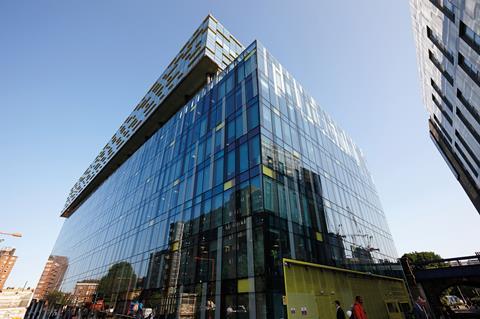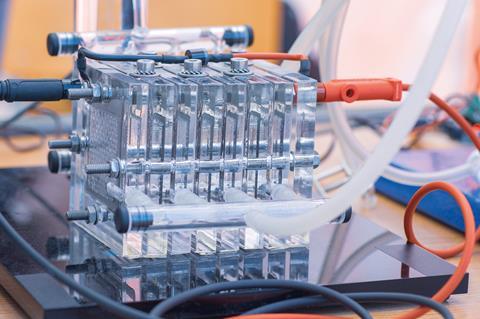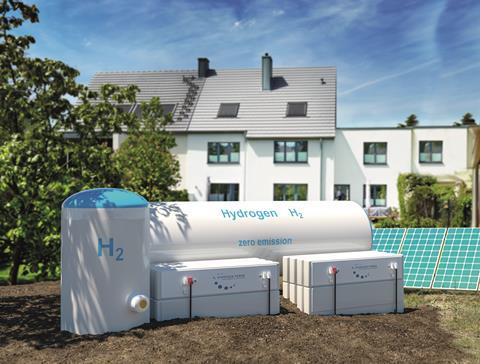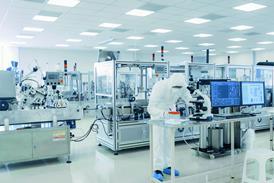With interest in green hydrogen escalating rapidly over the last few months, Agnieszka Krzyzaniak and Mark Stewart of Arcadis examine the benefits and challenges of this highly sustainable energy technology and consider the likely impacts on the built environment of the coming hydrogen revolution

01 / Introduction
There’s a big buzz around hydrogen in 2021. So far, we have heard about this emerging energy source from UK prime minister Boris Johnson, US president Joe Biden and first vice-president of the European Commission, Frans Timmermans, not to mention representatives from businesses such as BP, Shell and Total.
Green hydrogen was named among the World Economic Forum’s top 10 “most exciting technologies” to have emerged in 2020, and Bloomberg predicts hydrogen could meet up to 24% of the world’s energy needs by 2050, creating a market worth $600bn. Elon Musk, who has so far expressed a sceptical view on hydrogen fuel cells, has been called on by Forbes to repent.
Actions speak louder than words, though, and indeed there have recently been multiple developments in the hydrogen arena, with both the EU and the US Department of Energy publishing their own hydrogen strategies.
Closer to home, UK government publications to have expressed high hopes about hydrogen include the Energy White Paper, the Transport Decarbonisation Strategy, the Industrial Decarbonisation Strategy, and of course the PM’s 10-point plan for a green industrial revolution. That last document sees hydrogen not only as essential to meeting Britain’s net zero goals but also as a means of levelling up, through provision of jobs outside London and South-east.
What makes hydrogen an exciting prospect is that using it creates no carbon dioxide. On top of that, it can be produced without the use of CO2 emitting technologies, and it is a substrate for production of other carbon-free products, such as ammonia, which can be used to make fuels and fertilisers. Its potential applications span heat, transport, industry and power generation, providing a vital source of low carbon energy as the transition to net zero accelerates.
However, generating so-called green hydrogen is currently cost-prohibitive and is in the early days of industrial-scale applications. So, before we can start reaping the benefits, multiple challenges need to be addressed. This article will describe the status and outlook for hydrogen generation and use, looking at the areas where it has most potential to make an impactful change, and analyse the likely consequences of a wide, large-scale shift to hydrogen for built environment industries.
Hydrogen is an important industrial gas – for decades it has been used in the production of ammonia and methanol and in oil refining. This colourless gas is associated with multiple colours, depending on its production route. Traditionally, it is obtained through carbon-intensive processes involving the use of either coal or natural gas that are far from environmentally friendly. A carbon-free route to hydrogen exists too: it involves splitting water molecules in a process called electrolysis and results in “green hydrogen”.
Hydrogen and its new colours
This process still requires improvement and is currently too expensive to compete with traditional methods. So an intermediate technology is under development – the production of “blue hydrogen” from natural gas, but with the emissions from the process captured in carbon capture, use and storage (CCUS) facilities. Such an approach will enable a gradual transition to take place, initially still with the use of traditional feedstock, but already with a reduced footprint, before a deeper transition to a completely green mix can take place.
The future vision of energy mix in the UK includes both green and blue hydrogen, while the EU sees blue hydrogen as an intermediate step towards 100% green hydrogen.
The work on obtaining this highly desirable molecule through other methods is ongoing, which means the list of hydrogen colours is not yet definitive.
The transition to the production of green hydrogen in the vast quantities needed to meet future energy demands is a huge challenge, but the wide spectrum of areas where it could contribute to decarbonisation drives the investment towards it.
02 / A wide range of applications
Hydrogen’s main contribution to net zero will be the reduction of the footprint from operational carbon, particularly from heat, which makes it relevant not only to big companies but also to millions of homeowners around the UK. It can also reduce embodied carbon emissions, such as through the decarbonisation of the blast furnace process for steel manufacturing or in helping cut nitrogen dioxide emissions from fertilisers needed to meet growing demand for vegetarian and vegan diets.
Reduction of the carbon footprint can be achieved either through direct replacement of fossil fuels or by using hydrogen as support for another net zero technology, such as heat pumps – the Climate Change Commission has proposed that hydrogen could be used in hybrid units as a “heat booster”. In some situations, hydrogen can also be a substrate for the production of carbon‑free fuels such as ammonia.
Some of the main areas in which the application of hydrogen offers a potential for significant carbon savings or even carbon footprint elimination are as follows:
Passenger transport
While hydrogen remains an option for passenger cars, as an alternative to or in a hybrid form with electricity, there are even bigger benefits to be achieved from its application to mass transport such as buses or rail. The recent announcement from the government about the upcoming shake-up of the UK bus network includes the elimination of diesel in favour of electric or hydrogen powered buses.
In rail, Network Rail’s cross-industry traction decarbonisation network strategy has developed a prototype hydrogen-powered train called Hydroflex as an alternative to electrification for passenger trains on less intensively used lines. In the longer term, ferries and aviation are also in the picture.
Goods transport and heavy plant
On the HGV front, companies such as Daimler and DAF are working on the development of hydrogen trucks. These would not require any dramatic changes to the operations of freight logistics, but would need fuelling infrastructure to be put in place.
In construction, firms including JCB are leading the way with field testing of hydrogen for heavy machinery such as excavators that will have a big impact on emissions associated with construction.
And even though it is still early days, the shipping industry is also eyeing opportunities to employ hydrogen in its decarbonisation efforts.
Heating buildings

The main focus of decarbonisation here will be on the electrification of heating. However, this shift is likely to face some limitations related to availability of sufficient capacity in the heat-pump sector, the pace of retrofit and availability of power in competition with other uses such as EV.
To accelerate heat decarbonisation, hydrogen could initially be blended with natural gas, as the addition of up to 20% does not require adjustments to current installations. Further down the line, upgrades could be done to enable either 100% hydrogen powered heating or a hybrid system.
A hybrid solution would be especially useful in old buildings for which deep retrofit is not viable and/or economically feasible and where installation of heat pumps alone would not provide required heating levels.
Power storage
One of the biggest challenges related to renewable energy generation is the issue of intermittent supply and the difficulty of balancing the network.
Because the production of green hydrogen will use large amounts of electricity, it can play a key role in storing the surplus renewable energy generated by wind power operating 24/7, while also helping to stabilise the grid.
Energy conversion rates are approximately 80%, which is comparable to other energy sources, and there are advantages over batteries in terms of suitability for long-term storage or large quantities of energy.
Industry
Hydrogen energy will be specially useful in hard-to-abate sectors such as steel and concrete production.
In steel, hydrogen has a double role to play. Many traditional blast furnaces are being replaced with electric ones that are not able to generate as high temperatures and require high-quality iron or steel scrap as the feedstock.
Using hydrogen as a fuel in a traditional furnace would allow the processing of low-grade iron ore while eliminating carbon emissions.
Another even more significant function of green hydrogen will be to replace coking coal in the reaction that separates oxygen from iron ore and produces the essential substrate in steel-making – direct reduced iron. In other industrial sectors, hydrogen offers the possibility to “clean” the production of fertilisers, methanol and even food processing, by reducing the emissions from other greenhouse gases such as nitrous dioxide.
All these examples highlight how hydrogen can increase the diversity and resilience of decarbonisation efforts, especially in conjunction with other technologies such as nuclear and renewable electricity.
This clearly illustrates the size of the opportunity at hand – an opportunity that is, however, matched by the scale of the challenges that must be overcome if hydrogen is to be scaled up and become a commodity chemical.

03 / Obstacles to be overcome to enable the hydrogen revolution
Hydrogen has the potential to provide benefits to a wide array of sectors, but this will require a massive investment in energy transition. The ambitions are high, with the UK aiming for 5GW of capacity by 2030 and the EU committing to 40GW. However, many challenges need to be addressed before all this can happen – from production, through storage and distribution, to the actual application.
We know how to produce hydrogen, but we need to make it cleaner
In the production of blue hydrogen, the process itself is already established. The challenges are to scale up production and to create sufficient capacity in integrated carbon capture and storage facilities. The UK has some of the best potential CCUS reservoirs in Europe, but their development is costly and technically challenging. Until recently, the risk has been too great for private investors without appropriate incentives or guarantees.
As a part of the UK’s 10-point plan for a green industrial revolution, co-investment in four major CCUS hubs to be operating by 2030 has been announced, together with the development of an appropriate pricing mechanism. Projects are already ongoing in the Humber (including National Grid and Equinor aiming for the capture of almost 17 million tonnes of CO2) and BP’s H2Teesside.
Scaling up green hydrogen production is more challenging, although again the basic principles are well established. Electrolysis uses direct electric current to drive a chemical reaction that would otherwise not occur spontaneously. Modern electrolysis technology can reach up to 80% efficiency, but it requires huge amounts of renewable power, which creates a cost barrier.
At present the price of so-called dirty hydrogen is approximately £0.70/kg, while its green equivalent is almost eight times more expensive. Over time, gas prices will increase to reflect carbon impact, but there is an important role for innovation aimed at improving electrolysis or developing other methods of green hydrogen production (for example through anaerobic digestion). This is one of the top priorities for the UK’s £1bn Net Zero Innovation Fund.
Looking forward, green hydrogen will enable the increased use of offshore wind assets through provision of the storage capacity that will enable continual generation. However, with many other industries placing bets on renewable electricity, including EVs and heat pumps, it becomes clear that the realisation of all these ambitions may require more than the UK’s planned fourfold expansion of wind power to 40GW proposed in the 10-point plan.
Storage and transportation require extra safety
Once hydrogen has been produced, it needs to be stored and delivered to its destination – and this is a source of another set of challenges. Hydrogen is the most abundant element, but it is also the lightest – lighter even than helium – and its energy density is low. For its storage and long-distance transportation to become economically viable, it needs to be compressed, liquefied or chemically combined. These processes require energy, very low temperatures, high pressure (350-700 bar) and even additional infrastructure – for example if turning hydrogen into ammonia.
There are additional health and safety implications to be considered, especially since hydrogen has a wide flammability range and a low ignition point. On top of that, it can cause steel to become brittle, which can make traditional tanks or piping prone to leaks. Experiments are under way in Keele and the North-east to confirm that distribution over local networks can be accomplished safely using natural gas installations if the hydrogen content in the blend does not exceed 20%. However, moving towards 100% hydrogen will require a much more detailed network review and upgrades such as the use of fibre-reinforced polymers for piping or connectors as well as the installation of a new network of compressor stations.
Regulations will need to be updated
Energy is a highly regulated market, and given the safety issues associated with hydrogen, the design of the safety and regulatory framework for the expanded use of hydrogen is a top priority.
Pilot projects that are under way looking at the use of hydrogen in domestic and industrial settings will provide the opportunity to develop and test the new regulatory framework. Putting the legislation in place is a further essential step to create the legal and commercial confidence on which investment can proceed. With the government committed to delivering 5GW of blue hydrogen by 2030, it will need to become a parliamentary priority.
04 / Upside and downside impact on different industry sectors
The timeline for making green hydrogen economically competitive with other fuels currently stretches to 2030 and beyond, but the effects of the hydrogen revolution will be felt by the construction sector much earlier.
And as with every revolution, there will be losers as well as winners. In many areas opportunities will increase – driven by the need to produce and also store and transport hydrogen – but in some, areas activity levels will drop.
The table below summarises the areas in which we can expect the increasing use of hydrogen to accelerate investment and activity and also those where workload might actually fall as a result of the hydrogen transition.
| Sector | Acceleration | Deceleration |
|---|---|---|
| Transport | The shift of HGVs and buses to hydrogen will create a demand for fuelling stations, and a distribution infrastructure | Delay or cancellation of electrification in remote areas where hydrogen trains can operate |
| Construction | Acceleration of the overall pace of housing retrofit due to the simplification of retrofit content (such as fewer heat pumps) | Reduction in the scale of deep retrofit required to make older stock suitable for use with heat pumps |
| Gas distribution | Network-wide upgrades to meet regulatory and safety requirements associated with hydrogen transport | |
| Carbon capture and storage | Delivery of an initial phases of 10MT of CCUS capacity by 2030 in line with Boris Johnson’s 10-point plan | |
| Blue and green hydrogen production | Large-scale investment in hydrogen hubs and CCU Localised investment in industrial scale electrolysers linked to renewable energy Innovation investment in hydrogen production from organic waste including waste-water sludge |
|
| Renewable energy | Expansion to offshore facilities to support achieving the 5GW hydrogen capacity by 2030 underpinned by guaranteed 24/7 power demand from hydrogen electrolysers Creation of facilities that would enable a switch between electricity and hydrogen |
05 / An open future
Tackling climate change is the biggest challenge now facing humanity, and energy transition is its main component. To make matters more daunting, it is also time constrained – we know that CO2 emissions need to be almost eliminated by 2050. By that time, hydrogen is expected to account for 20% of total final energy consumption.
This new energy source has a dual role to play in the energy transition.
Where electrification will be difficult to achieve or cannot generate sufficient power (for example in heavy industry), hydrogen could be used as an ultimate replacement for oil and natural gas. In other cases, it could be an intermediate between fossil fuels and renewables-based electricity or else a booster, as mentioned previously. In particular blue hydrogen, which is closer to implementation on the time horizon, can be seen as a means to de-risk energy transition.
But aside from its purely technical function in generating new kinds of energy, hydrogen also carries the potential to create a new type of economy. ��Ȧ and operating hydrogen and CCUS infrastructure will generate demand for new types of skills and new jobs. This will mean opportunities not only for previous oil and gas employees but also for other workers. Furthermore, jobs will be created in sectors such as construction around the necessary adjustments to our homes, vehicles and factories.
With so many strands of hydrogen-related research still ongoing, further opportunities will certainly arise in time. Our ability to tackle the related challenges collectively will play a crucial role in determining which of the hydrogen-based promises become reality and which ones will evaporate.
Acknowledgments
The authors would like to thank Paul Aspinall, Tim Cooper, Ben Harris, Nick Ooms, Tim Strong and Simon Rawlinson of Arcadis for their contributions to this article.























No comments yet